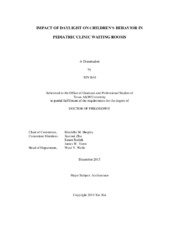| dc.description.abstract | Previous research has shown the stress-reduction effects of daylight, nature views, and other environmental factors among adult patients, however, limited research has been conducted on the stress-reducing effects of these factors on pediatric patients. The present study investigated the impact of daylight on children’s behaviors in pediatric waiting rooms through an observational study of over 1,000 children’s behaviors in a women and children’s clinic and a pediatric dental clinic in Texas. The observations were conducted over a five-week period with a total of 223 thirty-minute observation sessions. Children’s behaviors were observed and recorded with Noldus Observer® XT 10.5 behavioral mapping system during each session. Light levels, noise levels, and room temperature were also measured. Ten types of observed behaviors were categorized into negative behaviors (crying, shouting, hitting, fidgeting, getting out of their seats, and getting impatient and starting to talk to parents) and positive behaviors (laughing, running happily, singing, and speaking to oneself and making cute and funny sounds). Crying and singing were recorded by the duration of the occurrences in seconds. Other types of behaviors were recorded by the number of the occurrences.
Spearman’s rho in SPSS 21 was used to test two primary hypotheses: 1) the presence of higher levels of daylight would result in a decreased number of negative behaviors and 2) the presence of higher levels of daylight would result in an increased number of positive behaviors. Additional analyses such as calculating seating preferences from seating maps and comparing behavior frequency between the two rooms were also measured and analyzed using Mann Whitney U test. The main results suggested that higher levels of daylight are associated with less negative behaviors and more positive behaviors. Additionally, the researcher found that patients preferred to sit closer to windows and an overly bright waiting room wasn’t associated with better waiting experience.
The study expanded the knowledge of the impact of built environment on children’s behaviors. The findings can be applied to future pediatric waiting room design. Future designs are suggested to promote access to natural light and nature views, to provide family space, to reduce glare and noise, and to adopt child-proof space design and finishing materials. | en |


